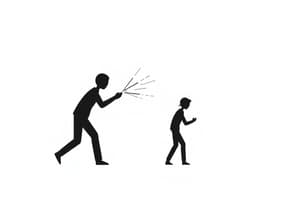Podcast
Questions and Answers
What is a key characteristic of Integral Stimulation in speech therapy?
What is a key characteristic of Integral Stimulation in speech therapy?
- It emphasizes the use of written scripts for practice.
- It focuses solely on visual models without auditory input.
- It requires the child to generate their own utterances independently.
- It involves imitation, auditory models, and visual models. (correct)
In Dynamic Temporal and Tactile Cueing (DTTC), what is the main goal for the child during therapy?
In Dynamic Temporal and Tactile Cueing (DTTC), what is the main goal for the child during therapy?
- To use augmentative devices for communication.
- To read scripts provided by the clinician.
- To take increasing responsibility for motor planning. (correct)
- To memorize sentence structures without cues.
What approach does the PROMPT method primarily focus on in speech therapy?
What approach does the PROMPT method primarily focus on in speech therapy?
- Relying on technology-based augmentative devices.
- Restructuring oral muscular phonetic targets. (correct)
- Using only verbal prompts for initiation.
- Improving auditory discrimination exclusively.
What is emphasized in Melodic Intonation Therapy (MIT) during treatment?
What is emphasized in Melodic Intonation Therapy (MIT) during treatment?
What is a key characteristic of Dynamic Temporal and Tactile Cueing (DTTC) used in treating Childhood Apraxia of Speech (CAS)?
What is a key characteristic of Dynamic Temporal and Tactile Cueing (DTTC) used in treating Childhood Apraxia of Speech (CAS)?
Which of the following therapies is integrated within the context of CAS treatment?
Which of the following therapies is integrated within the context of CAS treatment?
What principle is commonly emphasized in treatment strategies for Childhood Apraxia of Speech?
What principle is commonly emphasized in treatment strategies for Childhood Apraxia of Speech?
What is a potential challenge mentioned in the treatment of CAS?
What is a potential challenge mentioned in the treatment of CAS?
Which statement is true regarding Melodic Intonation Therapy (MIT) in CAS treatment?
Which statement is true regarding Melodic Intonation Therapy (MIT) in CAS treatment?
What must clinicians be cautious about when applying principles from non-speech motor learning literature to speech treatment for CAS?
What must clinicians be cautious about when applying principles from non-speech motor learning literature to speech treatment for CAS?
Why is careful planning essential in treatment for Childhood Apraxia of Speech?
Why is careful planning essential in treatment for Childhood Apraxia of Speech?
Motor learning is a process influenced only by physical practice.
Motor learning is a process influenced only by physical practice.
Practice conditions for speech motor learning include options such as massed and distributed practice.
Practice conditions for speech motor learning include options such as massed and distributed practice.
Knowledge of Results (KR) and Knowledge of Performance (KP) have shown systematic evidence in their efficacy in feedback conditions.
Knowledge of Results (KR) and Knowledge of Performance (KP) have shown systematic evidence in their efficacy in feedback conditions.
Childhood apraxia of speech (CAS) involves impairments in neuromuscular function.
Childhood apraxia of speech (CAS) involves impairments in neuromuscular function.
There is a gold standard treatment approach established for CAS.
There is a gold standard treatment approach established for CAS.
Inconsistent error production in speech can be a key feature of Childhood Apraxia of Speech.
Inconsistent error production in speech can be a key feature of Childhood Apraxia of Speech.
Treatment for Childhood Apraxia of Speech aims to enhance the retrieval and execution of motor plans for speech.
Treatment for Childhood Apraxia of Speech aims to enhance the retrieval and execution of motor plans for speech.
The evidence base for treatment approaches for CAS is well-established and comprehensive.
The evidence base for treatment approaches for CAS is well-established and comprehensive.
Match the following features of Childhood Apraxia of Speech (CAS) with their descriptions:
Match the following features of Childhood Apraxia of Speech (CAS) with their descriptions:
Match the following evidence types related to treatment approaches for Childhood Apraxia of Speech (CAS) with their characteristics:
Match the following evidence types related to treatment approaches for Childhood Apraxia of Speech (CAS) with their characteristics:
Match the following statements regarding the treatment of CAS with their implications:
Match the following statements regarding the treatment of CAS with their implications:
Match the following terms related to Childhood Apraxia of Speech with their meanings:
Match the following terms related to Childhood Apraxia of Speech with their meanings:
Match the treatment approach with its primary focus:
Match the treatment approach with its primary focus:
Match the type of feedback with its description:
Match the type of feedback with its description:
Flashcards are hidden until you start studying
Study Notes
Treatment Focus and Approaches
- Treatment for Childhood Apraxia of Speech (CAS) emphasizes movement rather than sound.
- Initial therapy includes maximum clinician support using visual, tactile, and auditory cues, which are gradually faded.
- The objective is to enhance movement accuracy, employing various motor learning principles in therapy.
Principles of Motor Learning (PML)
- Definitions: Motor Learning involves acquiring skills through experience and practice, influenced by multiple factors.
- Motor Performance vs. Motor Learning: The former pertains to execution during training; the latter deals with execution at another time (generalization).
- Key precursors to motor learning include motivation, attention, and pre-practice preparation.
- Important aspects for CAS include rate and prosody of speech.
PML: Practice Conditions
- Practice Amount: No systematic evidence favoring small or large amounts of practice.
- Practice Distribution: Undefined effects of massed versus distributed practice.
- Practice Variability: Limited evidence supporting variable practice benefits in unimpaired speech learning, no evidence for motor speech disorders (MSD).
- Practice Schedule: Little evidence for random practice effectiveness compared to blocked practice for untreated speech.
- Attentional Focus: No significant evidence supporting internal over external focus.
- Target Complexity: Limited evidence exists for targeting complex items for Apraxia treatment.
PML: Feedback Conditions
- Feedback Type: No systematic evidence distinguishing between Knowledge of Performance (KP) and Knowledge of Results (KR).
- Feedback Frequency: Some evidence suggests that reduced feedback frequency may be beneficial for AOS treatments.
- Feedback Timing: Delayed feedback could be advantageous in treating AOS and hypokinetic dysarthria.
Treatment Approaches/Methods
- Integral Stimulation and DTTC (Dynamic Temporal and Tactile Cueing).
- PROMPT (Prompts for Restructuring Oral Muscular Phonetic Targets).
- Nuffield Centre Dyspraxia Programme (NDP3).
- Rapid Syllable Transition Treatment (ReST).
- Melodic Intonation Therapy (MIT).
- Use of augmentative devices for communication enhancement.
- Generic approaches founded on PML principles.
- Stimulability Training Program (STP) and modified core vocabulary training (mCVT).
Integral Stimulation
- Articulation therapy focusing on imitation, auditory, and visual models, created by Robert Milisen in 1954.
- Emphasizes listening and visual attention in processing utterances.
- Utilizes prosodic cue methods like Melodic Intonation Therapy to enhance sentence structure and stress.
Dynamic Temporal and Tactile Cueing (DTTC)
- Designed for non-verbal children with severe CAS, building upon Integral Stimulation principles.
- Invites gradual independence from cues, promoting self-assembly of motor plans.
- Establishes foundational skills such as visual attention and imitation through parent involvement.
Methodological Challenges
- Lack of standard CAS definitions and differential diagnosis challenges.
- Significant symptom variability and social control issues in real clinical settings.
- Limited support for large-scale studies.
Treatment Planning Considerations
- Requires careful planning by clinicians and families, with understanding of multiple treatment methods and overlap.
- Clinicians must apply motor learning principles to structure treatment effectively.
- Caution is necessary when using insights from nonspeech motor learning literature for speech treatments.
Evidence and Research Gaps
- Studies indicate the quality of practice frequency significantly influences treatment outcomes.
- Mixed findings on high vs. low feedback frequency effectiveness for CAS treatment.
- Variability in practice schedule (blocked vs. random) remains inconclusive in outcomes for children with CAS.
- Augmentative Communication devices have shown potential benefits, albeit with limited support from case studies.
Childhood Apraxia of Speech (CAS)
- CAS is a neurological speech sound disorder in children, affecting speech movement precision without neuromuscular deficits.
- Causes may include known neurological impairments, complex neurobehavioral disorders, or idiopathic origins.
- Core issues lie in planning and programming speech movement sequences, resulting in errors in sound production and prosody.
Key Features of CAS
- Inconsistent error production for consonants and vowels across repeated attempts.
- Lengthened coarticulatory transitions and impaired sound sequencing.
- Inappropriate prosody, affecting rhythm and intonation.
Treatment Evidence
- There is no gold standard treatment for CAS due to insufficient controlled studies.
- Calls for more rigorous studies to assess treatment efficacy across the entire CAS population.
General Treatment Principles
- Treatment aims to enhance speech motor planning capabilities, focusing on movement rather than sound production.
- Initially, therapists provide high levels of support through visual, tactile, and auditory cues, which are gradually reduced.
- Approaches emphasize movement accuracy, aligned with motor learning principles.
Principles of Motor Learning (PML)
- Motor learning involves acquiring the capacity for skilled actions through practice and experience.
- Factors affecting motor learning include motivation, attention, practice conditions, and feedback.
- Key considerations for CAS treatment involve rate and prosody of production along with feedback conditions.
Feedback and Practice Conditions
- Evidence regarding practice amounts (small vs. large), distribution (massed vs. distributed), and variability (constant vs. variable) is limited.
- Feedback types (knowledge of performance vs. results) and frequencies (high vs. low) show mixed evidence regarding their efficacy.
Treatment Approaches
- Integral Stimulation and Dynamic Temporal and Tactile Cueing (DTTC) are key methods used in therapy.
- Other approaches include Prompts for Restructuring Oral Muscular Phonetic Targets (PROMPT), Nuffield Centre Dyspraxia Programme (NDP3), and Melodic Intonation Therapy (MIT).
Integral Stimulation
- Developed by Robert Milisen, focuses on imitation using auditory and visual models to promote articulation.
- Encourages functional communication by emphasizing prosodic cues early in treatment.
Dynamic Temporal and Tactile Cueing (DTTC)
- Modified version of Integral Stimulation for children with severe CAS, developed by Edythe Strand.
- Allows for gradual responsibility transfer to the child in speech motor planning through structured steps.
Evidence for Treatment Efficacy
- Various studies indicate a positive impact of treatments like Integral Stimulation and DTTC on articulation and verbal communication.
- Combined approaches, like Stimulability Training Program (STP) with modified core vocabulary training, show promise for expanding phonetic capabilities.
Barriers to Research Evidence
- Issues include inconsistent definitions of CAS, diagnostic challenges, symptom heterogeneity, and variability over time.
- Difficulties in experimental control and lack of support for large-scale studies hinder evidence generation.
Conclusions
- Effective treatment planning entails clinician-family collaboration, knowledge of different approaches, and an understanding of motor learning principles.
- Caution is necessary when applying motor learning insights from nonspeech contexts to CAS treatment.
Childhood Apraxia of Speech (CAS)
- CAS is a neurological speech sound disorder in children, affecting speech movement precision without neuromuscular deficits.
- Causes may include known neurological impairments, complex neurobehavioral disorders, or idiopathic origins.
- Core issues lie in planning and programming speech movement sequences, resulting in errors in sound production and prosody.
Key Features of CAS
- Inconsistent error production for consonants and vowels across repeated attempts.
- Lengthened coarticulatory transitions and impaired sound sequencing.
- Inappropriate prosody, affecting rhythm and intonation.
Treatment Evidence
- There is no gold standard treatment for CAS due to insufficient controlled studies.
- Calls for more rigorous studies to assess treatment efficacy across the entire CAS population.
General Treatment Principles
- Treatment aims to enhance speech motor planning capabilities, focusing on movement rather than sound production.
- Initially, therapists provide high levels of support through visual, tactile, and auditory cues, which are gradually reduced.
- Approaches emphasize movement accuracy, aligned with motor learning principles.
Principles of Motor Learning (PML)
- Motor learning involves acquiring the capacity for skilled actions through practice and experience.
- Factors affecting motor learning include motivation, attention, practice conditions, and feedback.
- Key considerations for CAS treatment involve rate and prosody of production along with feedback conditions.
Feedback and Practice Conditions
- Evidence regarding practice amounts (small vs. large), distribution (massed vs. distributed), and variability (constant vs. variable) is limited.
- Feedback types (knowledge of performance vs. results) and frequencies (high vs. low) show mixed evidence regarding their efficacy.
Treatment Approaches
- Integral Stimulation and Dynamic Temporal and Tactile Cueing (DTTC) are key methods used in therapy.
- Other approaches include Prompts for Restructuring Oral Muscular Phonetic Targets (PROMPT), Nuffield Centre Dyspraxia Programme (NDP3), and Melodic Intonation Therapy (MIT).
Integral Stimulation
- Developed by Robert Milisen, focuses on imitation using auditory and visual models to promote articulation.
- Encourages functional communication by emphasizing prosodic cues early in treatment.
Dynamic Temporal and Tactile Cueing (DTTC)
- Modified version of Integral Stimulation for children with severe CAS, developed by Edythe Strand.
- Allows for gradual responsibility transfer to the child in speech motor planning through structured steps.
Evidence for Treatment Efficacy
- Various studies indicate a positive impact of treatments like Integral Stimulation and DTTC on articulation and verbal communication.
- Combined approaches, like Stimulability Training Program (STP) with modified core vocabulary training, show promise for expanding phonetic capabilities.
Barriers to Research Evidence
- Issues include inconsistent definitions of CAS, diagnostic challenges, symptom heterogeneity, and variability over time.
- Difficulties in experimental control and lack of support for large-scale studies hinder evidence generation.
Conclusions
- Effective treatment planning entails clinician-family collaboration, knowledge of different approaches, and an understanding of motor learning principles.
- Caution is necessary when applying motor learning insights from nonspeech contexts to CAS treatment.
Studying That Suits You
Use AI to generate personalized quizzes and flashcards to suit your learning preferences.




